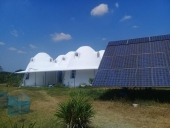posted 4 months ago
I doubt you f-ed it up. In my (admittedly somewhat limited) experience, both clay and lime are quite forgiving materials to work with. If you put a coat of 100% lime on a base of bone dry cob, it's gonna flake off horribly. But you can still brush off the flaky bits and then try again. A good rule of thumb is that like sticks to like. So you may have better luck trying a clay/lime mix as a scratch coat, then pure lime as a finish coat. Or maybe even two intermediate layers with 1:2 and 2:1 ratios.
The other thing I've learned about both of these materials is that slow drying is always better than fast drying. Drying happens by water moving towards the surface (or towards a dry material you slapped it onto that's now sucking up the moisture), and that creates an uneven drying (and therefore uneven shrinking) situation, which leads to cracking and flaking. In the heat of summer, working on an exterior wall, achieving that slow, even drying is easier said than done. Thoroughly wetting the dry surface (like, enough for it to really soak in, not just create a thin layer of dripping water) also helps keep the next layer from flaking off, but either way your life will be easier if you wait for an overcast/humid day.





